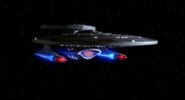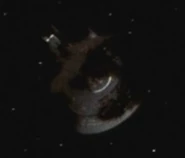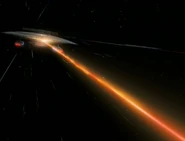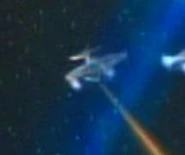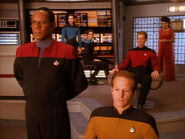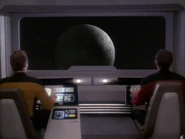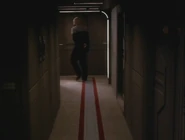No edit summary |
|||
| Line 80: | Line 80: | ||
== Interior design == |
== Interior design == |
||
| − | The ''Nebula''-class interior role was mainly the [[bridge]], of which several have been reported. The {{ShipClass|Galaxy}} is similar in style compared to the bridge was tight, austere décor, and was more spacious, brighter, with more instrumentation. This is proof that the modular bridge of boats can be interchangeable. Other |
+ | The ''Nebula''-class interior role was mainly the [[bridge]], of which several have been reported. The {{ShipClass|Galaxy}} is similar in style compared to the bridge was tight, austere décor, and was more spacious, brighter, with more instrumentation. This is proof that the modular bridge of boats can be interchangeable. Other premises have appeared only a few times, because the ''Nebula''-class has always been the only guests in the stories. These rooms and corridors are generally smaller and less clear were set about as the ''Galaxy''-class discrimination. Certain ''Nebula''-class ships have fewer cabins, more than others, this implies that each vessel in the lower window of several others was the saucer. ({{TNG|The Wounded|Redemption}}; {{DS9|Second Sight|Waltz}}; {{VOY|Message in a Bottle}}) [http://www.ex-astris-scientia.org/articles/nebula.htm] |
{{bginfo|Some fans of the ''Nebula''-class interior design drawings also appeared in the ''Galaxy''-class bridges.}} |
{{bginfo|Some fans of the ''Nebula''-class interior design drawings also appeared in the ''Galaxy''-class bridges.}} |
||
Revision as of 02:36, 5 August 2012
The Nebula-class was a type of Federation starship that was in service in Starfleet during the latter half of the 24th century.
History
Construction of the Nebula-class was spearheaded under the authority of the Yoyodyne Division, and ranged in construction dates from as early as 2363 to as late as 2367. Vessels including USS Phoenix and USS Sutherland were constructed at this time at both the 40 Eridani A Starfleet Construction Yards and later the San Francisco Fleet Yards, orbiting Earth. (TNG: "The Wounded", "Redemption II" dedication plaques)
The mission profile of the Nebula-class varied from performing various scientific and exploratory roles to conducting patrol and transport duties. (DS9: "Second Sight", "Explorers"; TNG: "Brothers" set artwork; TNG: "Sarek", "The Game")
The Nebula-class was present in several major Federation engagements against the Borg, including the Battle of Wolf 359 and the Battle of Sector 001. (DS9: "Emissary"; Star Trek: First Contact) They were also present in numerous Dominion War battles, including the Second Battle of Chin'toka and Battle of Cardassia. (DS9: "The Changing Face of Evil", "What You Leave Behind"). A Nebula class starship, the USS Farragut (NCC-60597) was sent to transport the crew of the Enterprise off a planet after the saucer section crash-landed due to a battle with a Klingon vessel (Star Trek Generations).
Technical data
Design
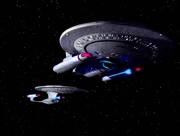
Nebula- and Template:ShipClass starships
The Nebula-class shared a similar design lineage with its larger Template:ShipClass counterpart. (TNG: "The Wounded", etc.)
The Nebula-class was composed of two hull sections; the saucer-shaped primary hull mounted atop the secondary hull, with two warp nacelles mounted on either side of the secondary hull, directly below the primary hull. (TNG: "The Wounded", etc.)
Atop the primary hull was a superstructure which could support a variety of modules, such as the inclusion of a triangular platform, fitted with torpedo launchers, an oval platform, or additional warp nacelles. (TNG: "Redemption II", "The Wounded", "Unification I")
By 2375, the Nebula-class was reconfigured slightly to include more of a Galaxy-class style secondary hull and deflector dish. (DS9: "The Changing Face of Evil")
By 2369, the Nebula-class served among historic model designs used in the classroom aboard Deep Space 9. (DS9: "The Nagus")
Defensive systems

Nebula class weapons range (left)
The Nebula-class was equipped with "a huge arsenal", at least according to Cardassian Gul Macet, which included multiple phaser banks and torpedo launchers. The Nebula-class had a maximum effective weapons range that exceeded 300,000 kilometers. (TNG: "The Wounded")
The typical offensive arsenal of the Nebula-class included a torpedo launcher located on the secondary hull above the deflector dish, and on some variants, a torpedo launcher located on the superstructure located above the primary hull. (Star Trek: First Contact; TNG: "Redemption II") Phaser positions included the forward-most part of the primary hull, and on the secondary hull, below the deflector dish. (VOY: "Non Sequitur", "Message in a Bottle", "Endgame"; DS9: "Emissary")
While considered more than a match for a Cardassian supply ship, the Nebula-class was also capable of successfully withstanding a direct hit from a Cardassian warship, as a result of an unshielded attack. (TNG: "The Wounded") They were, however, unable to single-handedly withstand an assault from a wing of Cardassian destroyers. (DS9: "Waltz")
Some Nebula-class starships, including the Phoenix, used a "high-energy sensor sweep" that cycled every 5.5 minutes. Between each of those cycles, a "window" of a fiftieth of a second would open, requiring the ship's shields to be realigned. (TNG: "The Wounded")
Propulsion systems
The propulsion systems for the Nebula-class were constructed under the authority of Yoyodyne Propulsion Systems. (TNG: "Redemption II" dedication plaque)
The engines of a Nebula-class needed to operate with a mixture above ninety percent in order to successfully leave orbit of a planet. Additionally, the starboard power coupling was located adjacent to decks ten through twelve. (TNG: "Redemption II")
In 2370, the theoretical maximum speed for the warp drive of Nebula-class starships, including the USS Prometheus was warp 9.5. When fine-tuned, the warp drive could be pushed to warp 9.6. (DS9: "Second Sight") By 2374, the USS Bonchune was able to pursue and catch the USS Prometheus, which was traveling at warp 9.9. (VOY: "Message in a Bottle")
In an alternate timeline, the Nebula-class was described as being "a lot faster" than a Template:ShipClass runabout. (VOY: "Non Sequitur")
Auxiliary craft
Nebula-class starships were equipped with a variety of auxiliary craft, including the Type 6 and Type 7 shuttlecraft, as well as the smaller Type 15 shuttlepod, and other large shuttlecraft. (DS9: "Waltz", "Wrongs Darker Than Death or Night", "Tears of the Prophets", "Second Sight"; Star Trek Generations)
Interior design
The Nebula-class interior role was mainly the bridge, of which several have been reported. The Template:ShipClass is similar in style compared to the bridge was tight, austere décor, and was more spacious, brighter, with more instrumentation. This is proof that the modular bridge of boats can be interchangeable. Other premises have appeared only a few times, because the Nebula-class has always been the only guests in the stories. These rooms and corridors are generally smaller and less clear were set about as the Galaxy-class discrimination. Certain Nebula-class ships have fewer cabins, more than others, this implies that each vessel in the lower window of several others was the saucer. (TNG: "The Wounded", "Redemption"; DS9: "Second Sight", "Waltz"; VOY: "Message in a Bottle") [2]
Bridge
Other interiors
Ships commissioned
- Named
- USS Bellerophon (NCC-62048)
- USS Bonchune (NCC-70915)
- USS Farragut (NCC-60597)
- USS Honshu (NCC-60205)
- USS Leeds (NCC-70352)
- USS Lexington
- USS Merrimac (NCC-61827)
- USS Monitor (NCC-61826)
- USS Phoenix (NCC-65420)
- USS Prometheus (NCC-71201)
- USS Sutherland (NCC-72015)
- USS T'Kumbra
- Unnamed
- Uncertain
- USS Endeavour (NCC-71805)
- USS Hera
- USS Proxima
- USS Ulysses
Appendices
Appearances
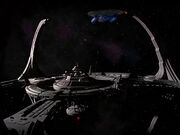
The Deep Space Nine title sequence featuring a Nebula-class ship
- TNG:
- DS9:
- "Emissary"
- "The Nagus" (model)
- "Second Sight"
- "Explorers"
- "The Way of the Warrior" (model)
- "The Visitor"
- "Doctor Bashir, I Presume"
- "Favor the Bold" (display graphic)
- "Sacrifice of Angels"
- "Waltz"
- "The Reckoning"
- "Profit and Lace"
- "Take Me Out to the Holosuite"
- "The Changing Face of Evil"
- "What You Leave Behind"
- In addition to the episode-specific appearances above, the Nebula-class, in the form of the USS Leeds, appears in every title sequence of Star Trek: Deep Space Nine from "The Way of the Warrior" to "What You Leave Behind".
- VOY:
- Star Trek films:
Background information
Aside from the dedication plaque reference in "Redemption II" and "Second Sight", the Nebula-class was referred to by name in "The Wounded", and "Non Sequitur". It was additionally referred to by name in the script notes for "Redemption II".
Studio models
First appearing as prototype kit-bash studio model in the debris field of "The Best of Both Worlds, Part II", the design of the Template:ShipClass was upgraded to a full worthy studio model, to represent a major class of starship. As Michael Okuda explains on Doug Drexler's blog, "The original concept for the Nebula-class ship was to develop a design that was in the style that Andy Probert had so brilliantly established for the Enterprise-D. (You may recall that every other Federation starship in early TNG episodes was made with recycled movie ships.) Our initial hope was that Greg could use the same molds from the 4' Enterprise-D, but that he could add a bigger bridge and give it bigger windows. The idea was to suggest that this ship was a contemporary of the E-D, but it was a smaller vessel." [3]
The BoBW kit-bash models
Ed Miarecki designed and built two Nebula-class vessels to appear in the debris field of the "The Best of Both Worlds" episode. Okuda remembers, "Nebula-class USS Melbourne. The original version of the Nebula. Ed made us two nearly-identical Melbourne models. I destroyed one of them to create a battle-damaged ship for BOBW2. (I recall being up in the art department one evening, Dremel tool in hand, cutting up the ship, while Patrick Stewart, in Borg costume, came upstairs to use the Xerox machine. He asked me what I was doing. I showed him the model and said something like, "See what you did!") Rick Sternbach helped with the battle damage, too. And Greg Jein contributed quite a bit of wreckage as well. The other Nebula model ended up on one of the side tables in Sisko's office in DS9. I think it was labeled "Melbourne," too."[4]
The models, built from parts of Template:ShipClass AMT Star Trek model kits, No's 6618 and 6619, differed from its later definitive appearance in that they sported two smaller warp nacelles where the sensor pod was to be positioned and that the secondary hull was more elongated. Sisko's desk top model (having made two early appearances as desktop model in TNG: "Future Imperfect", "The Wounded"), representing the destroyed Melbourne was refitted with a sensor pod after its first few appearances in Star Trek: Deep Space Nine.
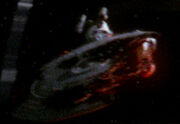
Wrecked Nebula-class USS Melbourne
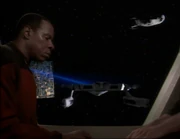
As a nameless wreck, in a window of an escape pod
For "Emissary", the producers decided to use the more detailed Template:ShipClass studio model to represent the USS Melbourne, thus robbing the proto-nebula from its name and registry. Stock footage of the now nameless distressed model is present in the episode (seen in the window of Benjamin Sisko's escape pod, just as it leaves the doomed USS Saratoga), making it the only studio model, besides the Borg cube model, to appear in both depictions of the Battle of Wolf 359 and its aftermath.
The physical studio model
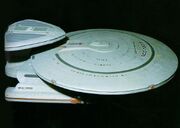
As the USS Sutherland

First appearance of the studio model as the USS Phoenix
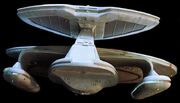
Rear view of the Sutherland
The design upgrades for the Nebula-class were done by Mike Okuda and Rick Sternbach and the model was built by Greg Jein. In Drexler's blog, Okada elaborates further: "As so often happens with this kind of project, we didn't give Greg enough time to accomplish this, so we decided to retain the original scale of the Galaxy-class ship saucer. I suggested the original 'AWACS' pod in response to a producer's observation that the ship might otherwise appear unbalanced. Unfortunately, the AWACS pod didn't look as elegant as we had hoped in "The Wounded". Rick Sternbach came to the rescue with the cool triangular pod that we used in later episodes." The time constraints could also explain why the USS Phoenix is not equipped with reaction control thruster assemblies. Fortunately, Jein was able to save time by using the molds of the recently constructed 4-foot Template:ShipClass to cast the saucer section and the nacelles.
As to the apparent lack of impulse thruster on the model Sternbach commented in the same blog, "One of the rationalizations I imagined ages ago for having no obvious impulse grilles involved capturing and compressing the impulse fusion reaction exhaust and later releasing it from special non-propulsive ports. If the Nebula-class was employed in a stealthy surveillance mode, it would be smart to minimize all overboard emissions. Since most all 'modern' impulse engines involve little or no pure rocket thrust, but more of a sub-warp drive, one could say that the familiar orange Starfleet glowy exhausts could be modified or eliminated."[5]
The model was used extensively, redressed (mostly done by Drexler and Okuda) several times to represent multiple vessels in later seasons of Star Trek: The Next Generation and the first three seasons of Deep Space Nine. [6]
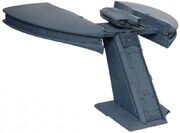
The alternate sensor pod mock-up by Doug Drexler

Re-design of the sensor pod (Notice the elongated secondary hull carried over from Miarecki's BoBW models)
When the shape of the sensor pod was reconsidered, Doug Drexler was also asked to come up with an alternative, "At one point, Dan Curry called Mike indicating that we may need an AWAC pod variant. We obliged by kludging one together. We ultimately did not use it.", Drexler remembered, who used amongst others, parts of a Miranda class model kit and computer keyboards.[7] Instead the producers followed Sternbach's re-design. Drexler's part, measuring 12"x11"x6", turned up on 8 August 2010 as Lot #76 in the Propworx' "Star Trek Prop and Costume Auction", estimated at US$600-$800, where it sold for US$350 (including buyer's premium).[8]

Detail shots of the model after refurbishment
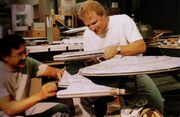
Modelers Larry Tan (l) and John Goodson finishing up on the refurbished studio model
In 1994 the model underwent extensive refurbishment done at the Industrial Light & Magic workshop supervised by modeler John Goodson for Star Trek Generations. The model was totally stripped from its original paint scheme (white with duck-egg blue highlights) and a new more detailed paint scheme, necessary to meet big screen requirements, was applied (blue-gray with metallic blue highlights) to represent the USS Farragut (Cinefex, No.61, 1994, page 69). In its new livery the model was used to represent the USS Leeds, for the upgraded opening title sequence of the last four seasons of DS9. Since no dorsal shots were made for this sequence, the Farragut decals on top of the saucer were not replaced. The last time the model was shot, was for a battle scene in Star Trek: First Contact as an unnamed vessel (although the model was still wearing the Farragut/Leeds decals, the shot was composed in a way that name and registry were not discernible).
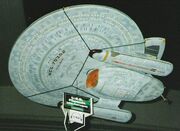
The Leeds/Farragut on tour
The physical studio model itself, worn and showing its age[9] has escaped the 40 Years of Star Trek: The Collection and It's A Wrap! sale and auctions, and is still in the possession of Paramount Pictures, having been on tour as late as 2011. After closure of the Star Trek The Exhibition tour at the Kennedy Space Center, FA. on 31 October 2011, the model was pulled from the tour circuit and remanded in temporary custody of Alec Peters of Propworx, Inc.. [10] Damaged from years of intensive handling on the tour circuit, Peters stated in private correspondence with Ex Astris Scientia that, "It will be restored and then who knows where it will wind up, but wont be sold. It is part of the CBS archive now! I have already contacted Greg Jein about restoring it."
The CGI model
For appearances in the later seasons of Deep Space Nine and Voyager a CGI model was built at Foundation Imaging in 1997 by Robert Bonchune, making its debut in VOY: "Message in a Bottle". In a ploy that was reminiscent of what Jein had done, constructing the physical model, Bonchune said, "I got to have as reference, sitting at the front of my desk, the actual filming miniature! It was a good 4 feet across. In the effort to be expedient, I did "kitbash" existing parts of the CG USS Enterprise-D, but it still needed completely new parts and major changes to existing maps to match the miniature,". (Sci-Fi & Fantasy Models, issue 32, 1998, p.54) The utilization of the parts of the Galaxy model went a long way explaining why the CGI Nebula differed slightly in appearance from its physical counterpart in that both the center line section of the secondary hull and the saucer rim were slimmer, suggesting, on screen at least, one deck less each. The most significant difference was the change of the shape of the deflector dish housing to an oval shape akin to the Galaxy-class. Also, the CGI Enterprise-D sported the original gray-blue/duck-egg blue paint scheme, mapped onto that model from high resolution pictures taken from her four-foot physical counterpart, which was also transferred onto the Nebula model instead of the new paint scheme applied at ILM. [11]
Bonchune's model went on to make several appearances in and onto licensed Star Trek publications, most notably in the Star Trek: Ships of the Line calendars and their book derivative.
Technical Manual
The following information of specifications and defenses comes exclusively from the Star Trek: Deep Space Nine Technical Manual:
- Production Base: ASDB Integration Facility, Utopia Planitia Fleet Yards, Mars
- Type: Explorer
- Accommodation: 750 officers and crew; 130 visiting personnel; 9,800 personal evacuation limit
- Power Plant: One 1,500 plus Cochrane warp core feeding two nacelles; one impulse system
- Dimensions: Length, 442.23 meters; beam, 318.11 meters; height: 130.43 meters
- Mass: 3,309,000 metric tonnes
- Performance: Warp 9.6 for 12 hours (STD); warp 9.9 for 12 hours (UPRTD)
- Armament: Eight type-10 phaser emitters; two photon torpedo launchers
Apocrypha

A Nebula-class ship in Star Trek: Legacy
- A cross section and overview of the ship is given in issue 154 of Star Trek: Communicator, particularly focusing on the "USS Nebula (NCC-60147)." The cross section shows that the ship is capable of saucer separation, has eight type-X phaser arrays and three photon torpedo launchers, and a mass of 3,309,000 metric tonnes. One inconsistency among the graphics has the registry number "NCC-60000" on the nacelle wing. All artwork used was provided by Tim Earls.
- In the video games Star Trek: Armada and Star Trek: Armada II, the Nebula-class is depicted as a "science ship"; that is, it has four special weapons where other ship classes have just one. The special weapons allow the Nebula-class to disrupt enemy shields, destroy incoming torpedoes, temporarily duplicate an allied ship, or send an engineering team to an allied ship or station to repair its systems.
- In the video game Star Trek: Bridge Commander, there are four Nebula-class vessels. Three of these, the USS Nightingale, USS Khitomer and USS Berkeley, appear to be made specifically for the game and do not appear anywhere in Star Trek canon. The fourth Nebula-class vessel featured in the game is actually a canon ship, the USS Prometheus (NCC-71201), though it is the only one that doesn't play an important role in the game.
- In Star Trek: The Next Generation - Birth of the Federation the Nebula class is the Strike Cruiser of the Federation; a short range combat vessel mostly intended for planetary bombardment.
- In Star Trek Online, the Nebula-class is an "advanced research science vessel" that can create tachyon detection fields and grids which boost stealth detection and sensor abilities.
External links
- Template:NCwiki
- Template:Exastris
- Template:Exastris

